Assessing the Effects of Irrigation Water Salinity on Two Ornamental Crops by Remote Spectral Imaging
Abstract
1. Introduction
2. Materials and Methods
2.1. Experimental Setup
2.2. Plant Growth Variables Monitoring
2.3. Multispectral Image Collection and Processing
3. Results
3.1. Height and Above-Ground Biomass
3.2. Remotely Sensed Vegetation Index
4. Discussion
5. Conclusions
Author Contributions
Funding
Institutional Review Board Statement
Informed Consent Statement
Data Availability Statement
Conflicts of Interest
References
- USDA-NASS United States Department of Agriculture-National Agricultural Statistics Service 2016. Available online: https://www.nass.usda.gov/Publications/Ag_Statistics/2016/index.php (accessed on 9 December 2019).
- Parsons, L.R. Agricultural Use of Reclaimed Water in Florida: Food for Thought. J. Contemp. Water Res. Educ. 2018, 165, 20–27. [Google Scholar] [CrossRef]
- Parsons, L.R.; Sheikh, B.; Holden, R.; York, D.W. Reclaimed Water as an Alternative Water Source for Crop Irrigation. HortScience 2010, 45, 1626–1629. [Google Scholar] [CrossRef]
- FDACS Registered Nurseries and Stock Dealers 2019. Available online: https://www.fdacs.gov/Agriculture-Industry (accessed on 9 December 2019).
- Bloetscher, F.; Heimlich, B.N.; Romah, T. Counteracting the Effects of Sea Level Rise in Southeast Florida. J. Environ. Sci. Eng. 2011, 5, 1507–1525. [Google Scholar]
- Southeast Florida Regional Climate Change Compact Sea Level Rise Work Group (Compact) Unified Sea Level Rise Projection for Southeast Florida. Available online: https://southeastfloridaclimatecompact.org/wp-content/uploads/2015/10/2015-Compact-Unified-Sea-Level-Rise-Projection.pdf (accessed on 18 December 2019).
- Trimble, P.J.; Santee, E.R.; Neidrauer, C.J. Preliminary Estimate of Impacts of Sea-Level Rise on the Regional Water Resources of Southeastern Florida. J. Coast. Res. 1998, 26, 252–255. [Google Scholar]
- Marella, R.L. Water Withdrawals in Florida, 2012: U.S. Geological Survey Open-File Report 2015–1156; US Department of the Interior, US Geological Survey: Reston, VA, USA, 2015; p. 10.
- Jiang, J.; DeAngelis, D.L.; Anderson, G.H.; Smith, T.J. Analysis and Simulation of Propagule Dispersal and Salinity Intrusion from Storm Surge on the Movement of a Marsh–Mangrove Ecotone in South Florida. Estuaries Coasts 2014, 37, 24–35. [Google Scholar] [CrossRef]
- Park, J.; Obeysekera, J.; Irizarry, M.; Barnes, J.; Trimble, P.; Park-Said, W. Storm Surge Projections and Implications for Water Management in South Florida. Clim. Chang. 2011, 107, 109–128. [Google Scholar] [CrossRef]
- Kussul, N.; Lavreniuk, M.; Skakun, S.; Shelestov, A. Deep Learning Classification of Land Cover and Crop Types Using Remote Sensing Data. IEEE Geosci. Remote Sens. Lett. 2017, 14, 778–782. [Google Scholar] [CrossRef]
- Salmon, J.M.; Friedl, M.A.; Frolking, S.; Wisser, D.; Douglas, E.M. Global Rain-Fed, Irrigated, and Paddy Croplands: A New High Resolution Map Derived from Remote Sensing, Crop Inventories and Climate Data. Int. J. Appl. Earth Obs. Geoinf. 2015, 38, 321–334. [Google Scholar] [CrossRef]
- Shakoor, N.; Northrup, D.; Murray, S.; Mockler, T.C. Big Data Driven Agriculture: Big Data Analytics in Plant Breeding, Genomics, and the Use of Remote Sensing Technologies to Advance Crop Productivity. Plant Phenome J. 2019, 2, 1–9. [Google Scholar] [CrossRef]
- Huang, Y.; Chen, Z.; Yu, T.; Huang, X.; Gu, X. Agricultural Remote Sensing Big Data: Management and Applications. J. Integr. Agric. 2018, 17, 1915–1931. [Google Scholar] [CrossRef]
- Jin, X.; Kumar, L.; Li, Z.; Feng, H.; Xu, X.; Yang, G.; Wang, J. A Review of Data Assimilation of Remote Sensing and Crop Models. Eur. J. Agron. 2018, 92, 141–152. [Google Scholar] [CrossRef]
- Kasampalis, D.A.; Alexandridis, T.K.; Deva, C.; Challinor, A.; Moshou, D.; Zalidis, G. Contribution of Remote Sensing on Crop Models: A Review. J. Imaging 2018, 4, 52. [Google Scholar] [CrossRef]
- Cao, L.; Liu, K.; Shen, X.; Wu, X.; Liu, H. Estimation of Forest Structural Parameters Using UAV-LiDAR Data and a Process-Based Model in Ginkgo Planted Forests. IEEE J. Sel. Top. Appl. Earth Obs. Remote Sens. 2019, 12, 4175–4190. [Google Scholar] [CrossRef]
- Mtui, Y.P.; Erdbrügger, J.; Hussin, Y.A.; Leeuwen, L.M.V.; Kloosterman, E.H.; Ismail, M.H. Comparison of Forest Tree Parameters Extracted from Uav Optical and Tls Data in Both Tropical Rain and Temperate Forests. In Proceedings of the 38th Asian Conference on Remote Sensing 2017: Space Applications: Touching Human Lives, New Delhi, India, 1 January 2017. [Google Scholar]
- Ashapure, A.; Jung, J.; Yeom, J.; Chang, A.; Maeda, M.; Maeda, A.; Landivar, J. A Novel Framework to Detect Conventional Tillage and No-Tillage Cropping System Effect on Cotton Growth and Development Using Multi-Temporal UAS Data. ISPRS J. Photogramm. Remote Sens. 2019, 152, 49–64. [Google Scholar] [CrossRef]
- Doughty, C.L.; Cavanaugh, K.C. Mapping Coastal Wetland Biomass from High Resolution Unmanned Aerial Vehicle (UAV) Imagery. Remote Sens. 2019, 11, 540. [Google Scholar] [CrossRef]
- Ivushkin, K.; Bartholomeus, H.; Bregt, A.K.; Pulatov, A.; Franceschini, M.H.D.; Kramer, H.; van Loo, E.N.; Jaramillo Roman, V.; Finkers, R. UAV Based Soil Salinity Assessment of Cropland. Geoderma 2019, 338, 502–512. [Google Scholar] [CrossRef]
- Guan, S.; Fukami, K.; Matsunaka, H.; Okami, M.; Tanaka, R.; Nakano, H.; Sakai, T.; Nakano, K.; Ohdan, H.; Takahashi, K. Assessing Correlation of High-Resolution NDVI with Fertilizer Application Level and Yield of Rice and Wheat Crops Using Small UAVs. Remote Sens. 2019, 11, 112. [Google Scholar] [CrossRef]
- Hassan, M.A.; Yang, M.; Rasheed, A.; Yang, G.; Reynolds, M.; Xia, X.; Xiao, Y.; He, Z. A Rapid Monitoring of NDVI across the Wheat Growth Cycle for Grain Yield Prediction Using a Multi-Spectral UAV Platform. Plant Sci. 2019, 282, 95–103. [Google Scholar] [CrossRef]
- Brede, B.; Suomalainen, J.; Roosjen, P.; Aasen, H.; Kooistra, L.; Bartholomeus, H.; Clevers, J.; Herold, M. Opportunities of UAV Based Sensing for Vegetation Land Product Validation; European Space Agency: Rome, Italy, 2018. [Google Scholar]
- González-Jaramillo, V.; Fries, A.; Bendix, J. AGB Estimation in a Tropical Mountain Forest (TMF) by Means of RGB and Multispectral Images Using an Unmanned Aerial Vehicle (UAV). Remote Sens. 2019, 11, 1413. [Google Scholar] [CrossRef]
- Guo, X.; Wang, L.; Tian, J.; Yin, D.; Shi, C.; Nie, S. Vegetation Horizontal Occlusion Index (VHOI) from TLS and UAV Image to Better Measure Mangrove LAI. Remote Sens. 2018, 10, 1739. [Google Scholar] [CrossRef]
- Li, S.; Yuan, F.; Ata-UI-Karim, S.T.; Zheng, H.; Cheng, T.; Liu, X.; Tian, Y.; Zhu, Y.; Cao, W.; Cao, Q. Combining Color Indices and Textures of UAV-Based Digital Imagery for Rice LAI Estimation. Remote Sens. 2019, 11, 1763. [Google Scholar] [CrossRef]
- Alberton, B.; Torres, R.d.S.; Cancian, L.F.; Borges, B.D.; Almeida, J.; Mariano, G.C.; dos Santos, J.; Morellato, L.P.C. Introducing Digital Cameras to Monitor Plant Phenology in the Tropics: Applications for Conservation. Perspect. Ecol. Conserv. 2017, 15, 82–90. [Google Scholar] [CrossRef]
- Brocks, S.; Bareth, G. Estimating Barley Biomass with Crop Surface Models from Oblique RGB Imagery. Remote Sens. 2018, 10, 268. [Google Scholar] [CrossRef]
- Enciso, J.; Maeda, M.; Landivar, J.; Jung, J.; Chang, A. A Ground Based Platform for High Throughput Phenotyping. Comput. Electron. Agric. 2017, 141, 286–291. [Google Scholar] [CrossRef]
- Hall, F.G.; Hilker, T.; Coops, N.C. PHOTOSYNSAT, Photosynthesis from Space: Theoretical Foundations of a Satellite Concept and Validation from Tower and Spaceborne Data. Remote Sens. Environ. 2011, 115, 1918–1925. [Google Scholar] [CrossRef]
- Naito, H.; Ogawa, S.; Valencia, M.O.; Mohri, H.; Urano, Y.; Hosoi, F.; Shimizu, Y.; Chavez, A.L.; Ishitani, M.; Selvaraj, M.G.; et al. Estimating Rice Yield Related Traits and Quantitative Trait Loci Analysis under Different Nitrogen Treatments Using a Simple Tower-Based Field Phenotyping System with Modified Single-Lens Reflex Cameras. ISPRS J. Photogramm. Remote Sens. 2017, 125, 50–62. [Google Scholar] [CrossRef]
- Lyons, J.M. Chilling Injury in Plants. Annu. Rev. Plant Physiol. 1973, 24, 445–466. [Google Scholar] [CrossRef]
- Paredes, M.; Quiles, M.J. The Effects of Cold Stress on Photosynthesis in Hibiscus Plants. PLoS ONE 2015, 10, e0137472. [Google Scholar] [CrossRef]
- Hughes, J.D.; White, J.T. Hydrologic Conditions in Urban Miami-Dade County, Florida, and the Effect of Groundwater Pumpage and Increased Sea Level on Canal Leakage and Regional Groundwater Flow; U.S. Department of the Interior, U.S. Geological Survey: Reston, VA, USA, 2016; 175p.
- USGS USGS Water Data for the Nation 2019. Available online: https://waterdata.usgs.gov/nwis (accessed on 9 December 2019).
- Miami-Dade County Board of County Commissioners. Report on Flooding and Salt Water Intrusion; Miami-Dade County Board of County Commissioners: Miami-Dade County, FL, USA, 2016.
- Hilbert, D.W.; Swift, D.M.; Detling, J.K.; Dyer, M.I. Relative Growth Rates and the Grazing Optimization Hypothesis. Oecologia 1981, 51, 14–18. [Google Scholar] [CrossRef] [PubMed]
- Radford, P.J. Growth Analysis Formulae—Their Use and Abuse. Crop Sci. 1967, 7, 171–175. [Google Scholar] [CrossRef]
- Deng, J.; Ran, J.; Wang, Z.; Fan, Z.; Wang, G.; Ji, M.; Liu, J.; Wang, Y.; Liu, J.; Brown, J.H. Models and Tests of Optimal Density and Maximal Yield for Crop Plants. Proc. Natl. Acad. Sci. USA 2012, 109, 15823–15828. [Google Scholar] [CrossRef]
- Liu, J.-H.; Yan, Y.; Ali, A.; Yu, M.-F.; Xu, Q.-J.; Shi, P.-J.; Chen, L. Simulation of Crop Growth, Time to Maturity and Yield by an Improved Sigmoidal Model. Sci. Rep. 2018, 8, 7030. [Google Scholar] [CrossRef] [PubMed]
- Paine, C.E.T.; Marthews, T.R.; Vogt, D.R.; Purves, D.; Rees, M.; Hector, A.; Turnbull, L.A. How to Fit Nonlinear Plant Growth Models and Calculate Growth Rates: An Update for Ecologists. Methods Ecol. Evol. 2012, 3, 245–256. [Google Scholar] [CrossRef]
- Sprouffske, K.; Wagner, A. Growthcurver: An R Package for Obtaining Interpretable Metrics from Microbial Growth Curves. Bmc Bioinform. 2016, 17, 172. [Google Scholar] [CrossRef] [PubMed]
- Zeide, B. Analysis of Growth Equations. For. Sci. 1993, 39, 594–616. [Google Scholar] [CrossRef]
- Kheloufi, N.; Kahlouche, S.; Lamara, R.A.A. Non Linear Least Squares(Levenberg-Marquardt Algorithms) for Geodetic Adjustment and Coordinates Transformation; European Geosciences Union: Vienna, Austria, 2009; Volume 11, p. 333. [Google Scholar]
- Carlson, T.N.; Ripley, D.A. On the Relation between NDVI, Fractional Vegetation Cover, and Leaf Area Index. Remote Sens. Environ. 1997, 62, 241–252. [Google Scholar] [CrossRef]
- Rouse, J.W.; Haas, R.H.; Schell, J.A.; Deering, D.W. Monitoring Vegetation Systems in the Great Plains with ERTS. NASA Spec. Publ. 1974, 351, 309. [Google Scholar]
- Grime, J.P.; Hunt, R. Relative Growth-Rate: Its Range and Adaptive Significance in a Local Flora. J. Ecol. 1975, 63, 393–422. [Google Scholar] [CrossRef]
- Liu, X.; Bo, Y.; Zhang, J.; He, Y. Classification of C3 and C4 Vegetation Types Using MODIS and ETM+ Blended High Spatio-Temporal Resolution Data. Remote Sens. 2015, 7, 15244–15268. [Google Scholar] [CrossRef]
- Naser, M.A.; Khosla, R.; Longchamps, L.; Dahal, S. Using NDVI to Differentiate Wheat Genotypes Productivity Under Dryland and Irrigated Conditions. Remote Sens. 2020, 12, 824. [Google Scholar] [CrossRef]
- Shen, M.; Chen, J.; Zhu, X.; Tang, Y.; Chen, X. Do Flowers Affect Biomass Estimate Accuracy from NDVI and EVI? Int. J. Remote Sens. 2010, 31, 2139–2149. [Google Scholar] [CrossRef]
- Tieszen, L.L.; Reed, B.C.; Bliss, N.B.; Wylie, B.K.; DeJong, D.D. Ndvi, C3 and C4 Production, and Distributions in Great Plains Grassland Land Cover Classes. Ecol. Appl. 1997, 7, 59–78. [Google Scholar] [CrossRef]
- Chen, D.; Huang, J.; Jackson, T.J. Vegetation Water Content Estimation for Corn and Soybeans Using Spectral Indices Derived from MODIS Near- and Short-Wave Infrared Bands. Remote Sens. Environ. 2005, 98, 225–236. [Google Scholar] [CrossRef]
- Hao, F.; Zhang, X.; Ouyang, W.; Skidmore, A.K.; Toxopeus, A.G. Vegetation NDVI Linked to Temperature and Precipitation in the Upper Catchments of Yellow River. Environ. Model Assess 2012, 17, 389–398. [Google Scholar] [CrossRef]
- Ren, D.D.W.; Tripathi, S.; Li, L.K.B. Low-Cost Multispectral Imaging for Remote Sensing of Lettuce Health. J. Appl. Remote Sens. 2017, 11, 016006. [Google Scholar] [CrossRef]
- Dehm, D. A Small Unmanned Aerial System (SUAS) Based Method for Monitoring Wetland Inundation & Vegetation. Ph.D. Thesis, University of Toledo, Toledo, OH, USA, 2019. [Google Scholar]
- Bahe, M. Nursery Production Method Performance Evaluation Assessed with the Normalized Difference Vegetation Index Derived from an Unmanned Aircraft System Mounted Single-Imager Sensor. Master’s Thesis, University of Minnesota, Minneapolis, MN, USA, 2020. [Google Scholar]
- Coburn, C.A.; Smith, A.M.; Logie, G.S.; Kennedy, P. Radiometric and Spectral Comparison of Inexpensive Camera Systems Used for Remote Sensing. Int. J. Remote Sens. 2018, 39, 4869–4890. [Google Scholar] [CrossRef]
- Cucho-Padin, G.; Loayza, H.; Palacios, S.; Balcazar, M.; Carbajal, M.; Quiroz, R. Development of Low-Cost Remote Sensing Tools and Methods for Supporting Smallholder Agriculture. Appl. Geomat. 2020, 12, 247–263. [Google Scholar] [CrossRef]
- Burggraaff, O.; Schmidt, N.; Zamorano, J.; Pauly, K.; Pascual, S.; Tapia, C.; Spyrakos, E.; Snik, F. Standardized Spectral and Radiometric Calibration of Consumer Cameras. Opt. Expressoe 2019, 27, 19075–19101. [Google Scholar] [CrossRef]
- Del Pozo, S.; Rodríguez-Gonzálvez, P.; Hernández-López, D.; Felipe-García, B. Vicarious Radiometric Calibration of a Multispectral Camera on Board an Unmanned Aerial System. Remote Sens. 2014, 6, 1918–1937. [Google Scholar] [CrossRef]
- Iqbal, F.; Lucieer, A.; Barry, K. Simplified Radiometric Calibration for UAS-Mounted Multispectral Sensor. Eur. J. Remote Sens. 2018, 51, 301–313. [Google Scholar] [CrossRef]
- Berhane, T.M.; Costa, H.; Lane, C.R.; Anenkhonov, O.A.; Chepinoga, V.V.; Autrey, B.C. The Influence of Region of Interest Heterogeneity on Classification Accuracy in Wetland Systems. Remote Sens. 2019, 11, 551. [Google Scholar] [CrossRef]
- Guo, Y.; Senthilnath, J.; Wu, W.; Zhang, X.; Zeng, Z.; Huang, H. Radiometric Calibration for Multispectral Camera of Different Imaging Conditions Mounted on a UAV Platform. Sustainability 2019, 11, 978. [Google Scholar] [CrossRef]
- Rosas, J.T.F.; de Carvalho Pinto, F.D.A.; Queiroz, D.M.D.; de Melo Villar, F.M.; Martins, R.N.; Silva, S.D.A. Low-Cost System for Radiometric Calibration of UAV-Based Multispectral Imagery. J. Spat. Sci. 2020, 0, 1–15. [Google Scholar] [CrossRef]
- Flowers, T.J.; Colmer, T.D. Salinity Tolerance in Halophytes. New Phytol. 2008, 179, 945–963. [Google Scholar] [CrossRef]
- Sperling, O.; Lazarovitch, N.; Schwartz, A.; Shapira, O. Effects of High Salinity Irrigation on Growth, Gas-Exchange, and Photoprotection in Date Palms (Phoenix Dactylifera L., Cv. Medjool). Environ. Exp. Bot. 2014, 99, 100–109. [Google Scholar] [CrossRef]
- Cassaniti, C.; Romano, D.; Flowers, T.J. The response of ornamental plants to saline irrigation water. In Irrigation: Water Management, Pollution and Alternative Strategies; InTech: Rijeka, Croatia, 2012; pp. 131–158. [Google Scholar]
- García-Caparrós, P.; Lao, M.T. The Effects of Salt Stress on Ornamental Plants and Integrative Cultivation Practices. Sci. Hortic. 2018, 240, 430–439. [Google Scholar] [CrossRef]
- Niu, G.; Rodriguez, D.S. Relative Salt Tolerance of Selected Herbaceous Perennials and Groundcovers. Sci. Hortic. 2006, 110, 352–358. [Google Scholar] [CrossRef]
- Zollinger, N.; Koenig, R.; Cerny-Koenig, T.; Kjelgren, R. Relative Salinity Tolerance of Intermountain Western United States Native Herbaceous Perennials. HortScience 2007, 42, 529–534. [Google Scholar] [CrossRef]
- Garbez, M.; Belin, E.; Chéné, Y.; Dones, N.; Hunault, G.; Relion, D.; Sigogne, M.; Symoneaux, R.; Rousseau, D.; Galopin, G. A New Approach to Predict the Visual Appearance of Rose Bush from Image Analysis of 3D Videos. Eur. J. Hortic. Sci. 2020, 85, 182–190. [Google Scholar] [CrossRef]
- Santagostini, P.; Demotes-Mainard, S.; Huché-Thélier, L.; Leduc, N.; Bertheloot, J.; Guérin, V.; Bourbeillon, J.; Sakr, S.; Boumaza, R. Assessment of the Visual Quality of Ornamental Plants: Comparison of Three Methodologies in the Case of the Rosebush. Sci. Hortic. 2014, 168, 17–26. [Google Scholar] [CrossRef]
- Sun, Y.; Niu, G.; Masabni, J.G.; Ganjegunte, G. Relative Salt Tolerance of 22 Pomegranate (Punica Granatum) Cultivars. HortScience 2018, 53, 1513–1519. [Google Scholar] [CrossRef]
- Sun, Y.; Niu, G.; Perez, C.; Pemberton, H.B.; Altland, J. Responses of Marigold Cultivars to Saline Water Irrigation. HortTechnology 2018, 28, 166–171. [Google Scholar] [CrossRef]
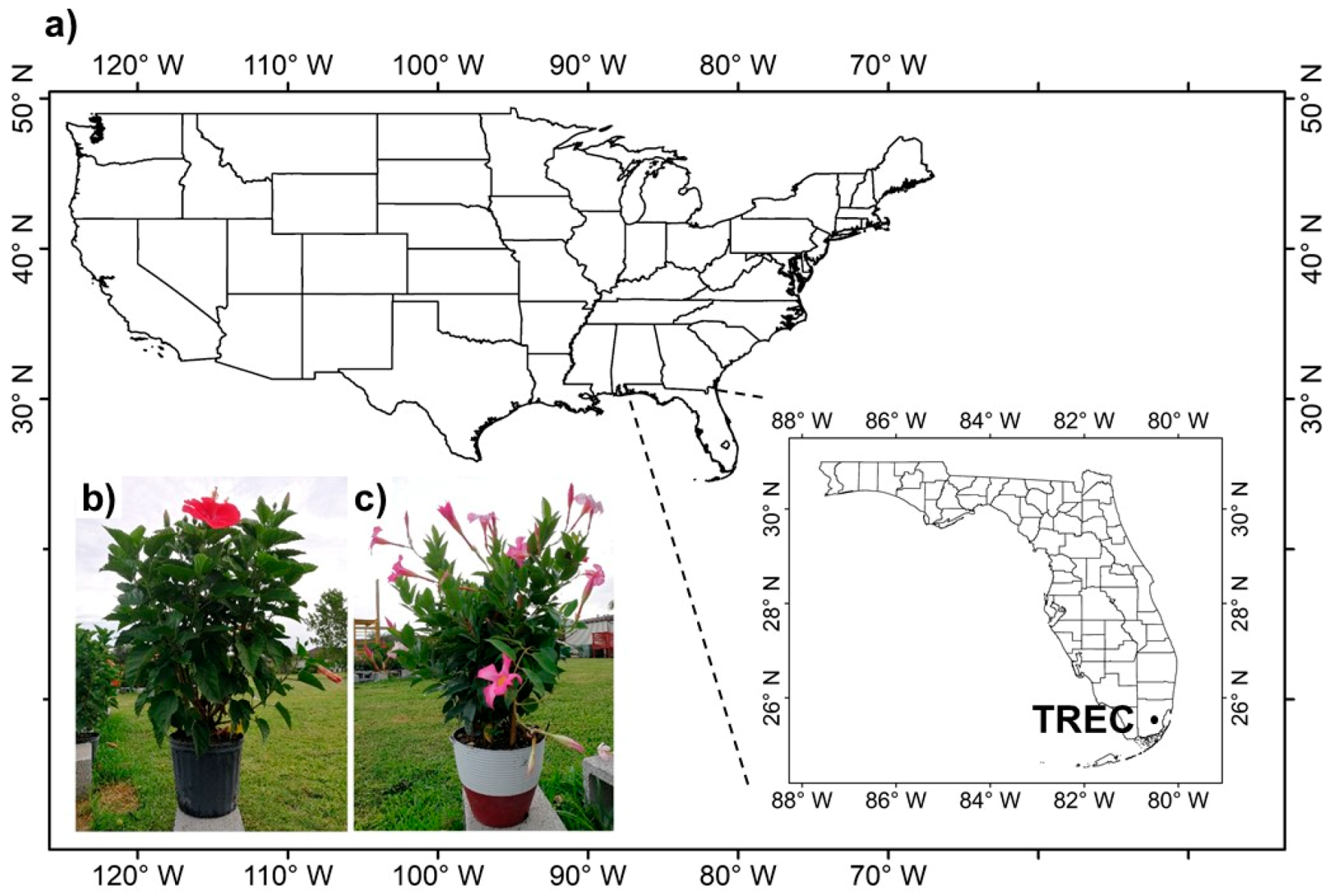

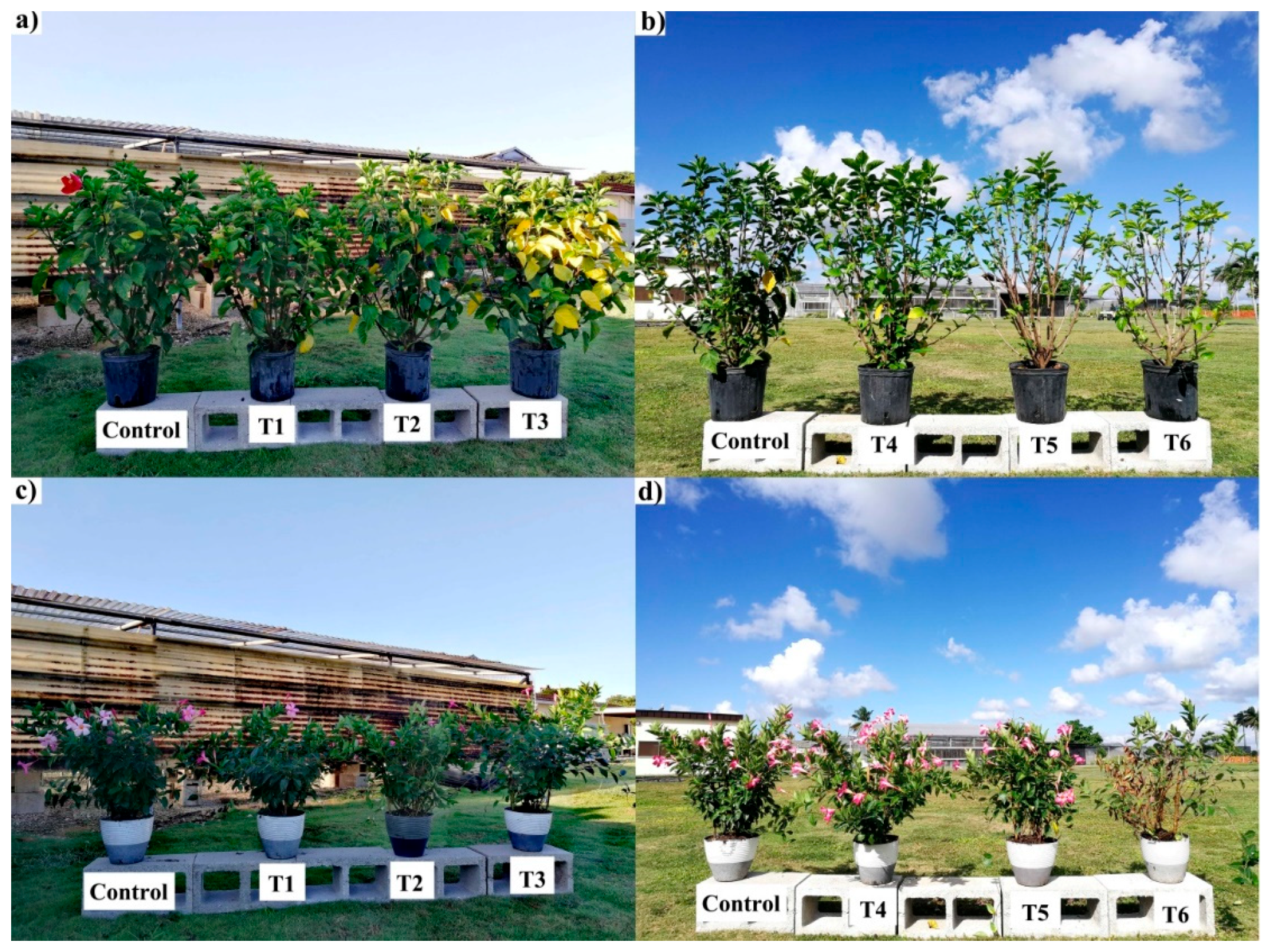

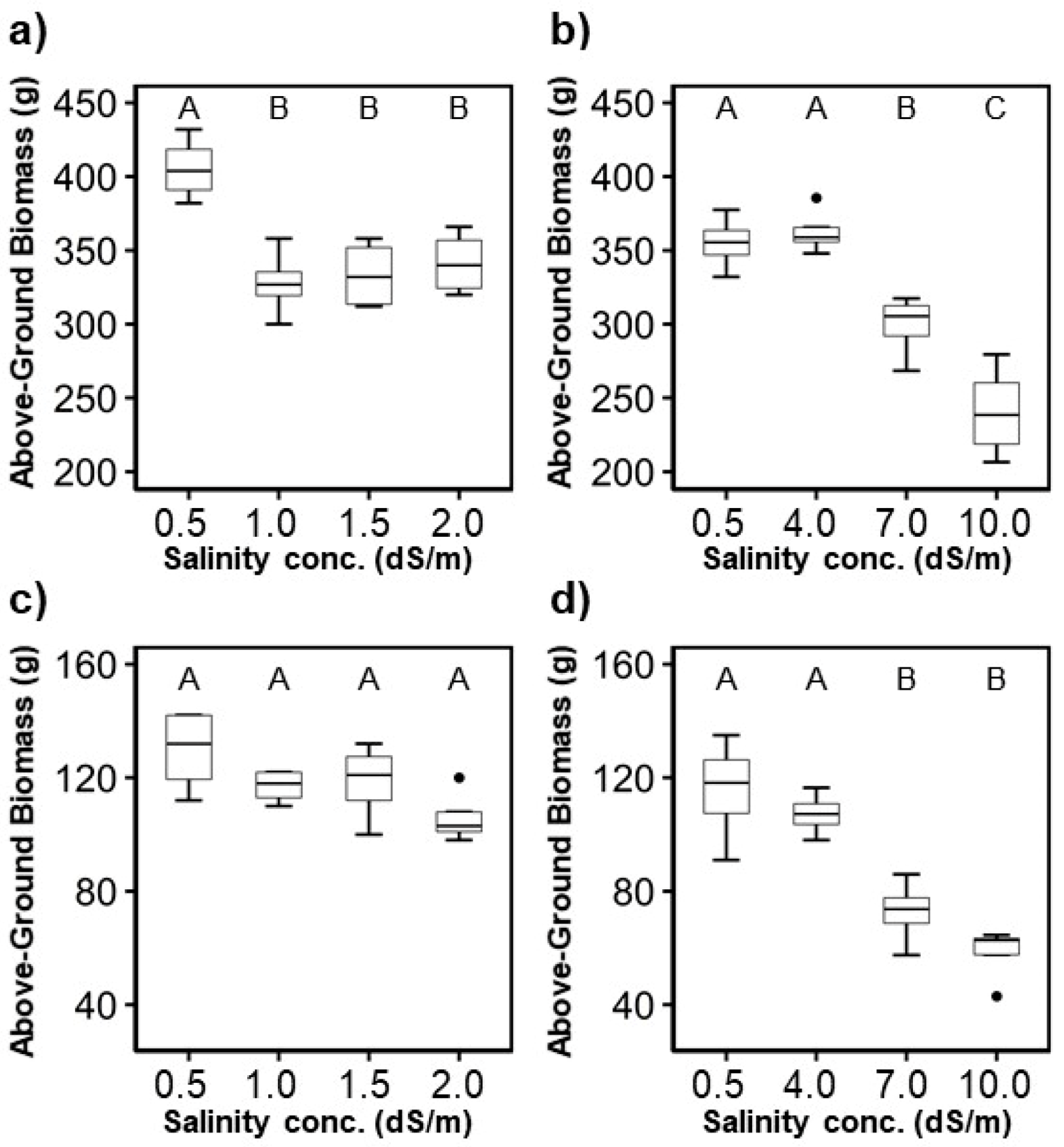
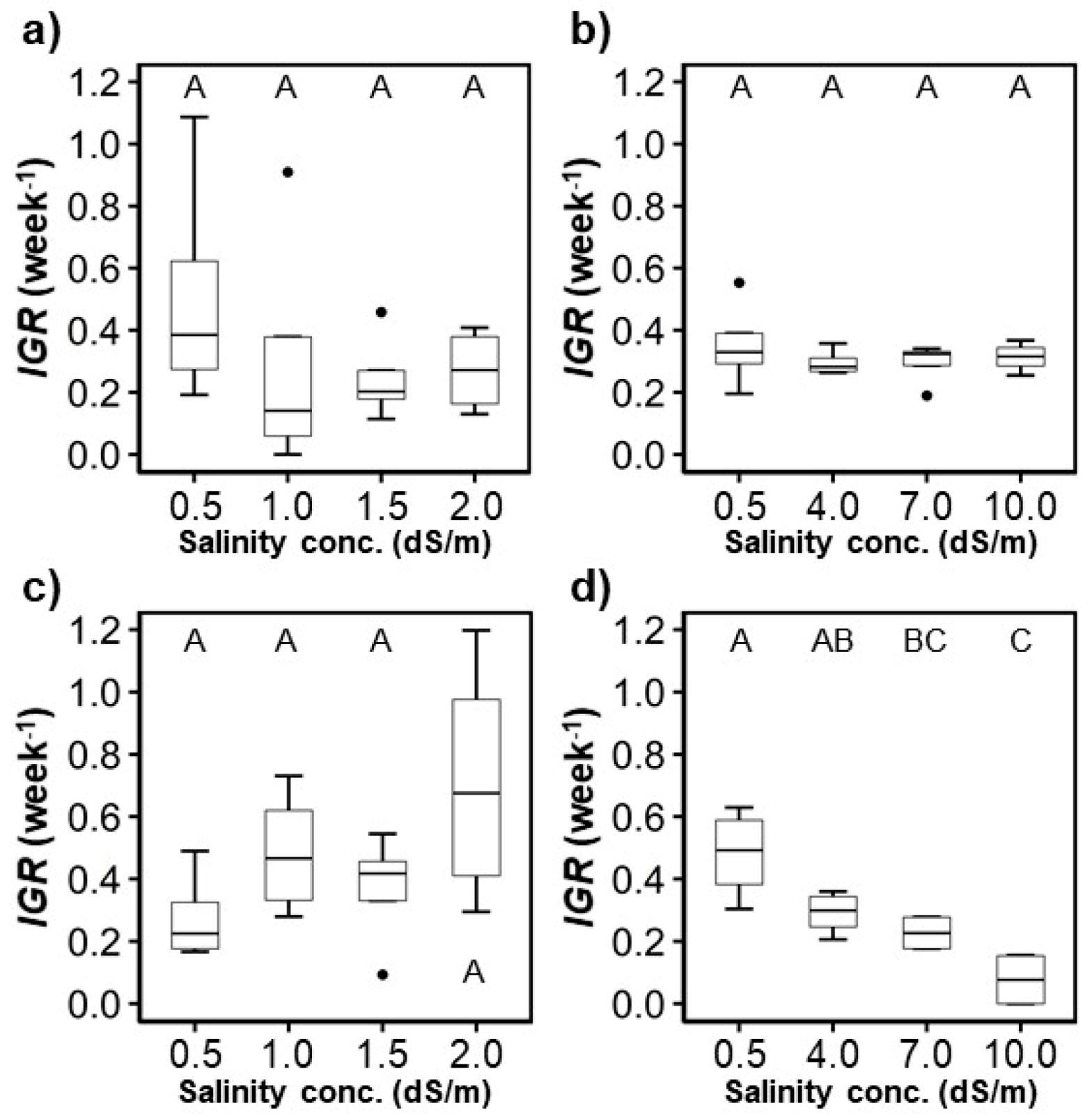

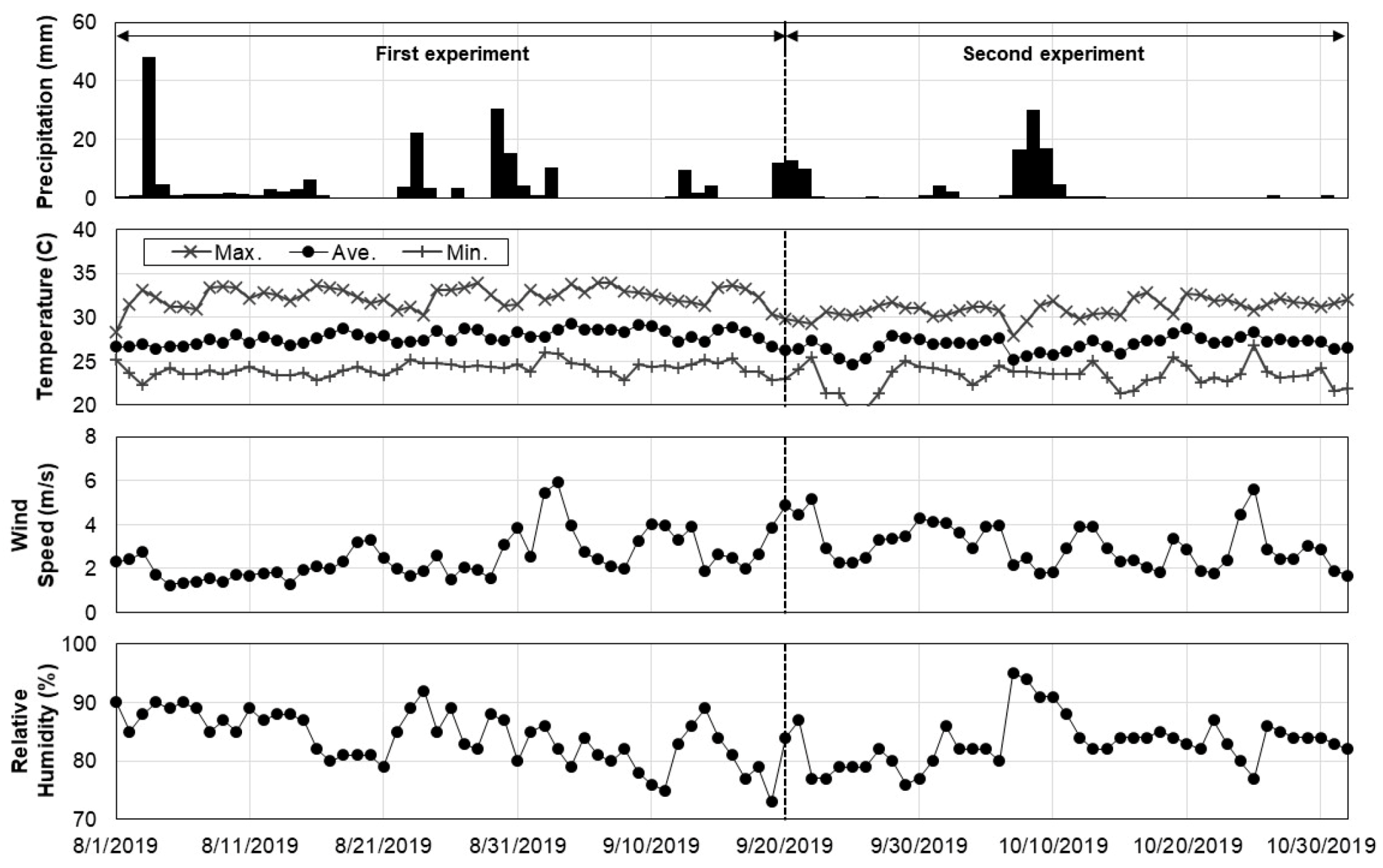
Publisher’s Note: MDPI stays neutral with regard to jurisdictional claims in published maps and institutional affiliations. |
© 2021 by the authors. Licensee MDPI, Basel, Switzerland. This article is an open access article distributed under the terms and conditions of the Creative Commons Attribution (CC BY) license (http://creativecommons.org/licenses/by/4.0/).
Share and Cite
Yu, X.; Her, Y.; Chang, A.; Song, J.-H.; Campoverde, E.V.; Schaffer, B. Assessing the Effects of Irrigation Water Salinity on Two Ornamental Crops by Remote Spectral Imaging. Agronomy 2021, 11, 375. https://doi.org/10.3390/agronomy11020375
Yu X, Her Y, Chang A, Song J-H, Campoverde EV, Schaffer B. Assessing the Effects of Irrigation Water Salinity on Two Ornamental Crops by Remote Spectral Imaging. Agronomy. 2021; 11(2):375. https://doi.org/10.3390/agronomy11020375
Chicago/Turabian StyleYu, Xinyang, Younggu Her, Anjin Chang, Jung-Hun Song, E. Vanessa Campoverde, and Bruce Schaffer. 2021. "Assessing the Effects of Irrigation Water Salinity on Two Ornamental Crops by Remote Spectral Imaging" Agronomy 11, no. 2: 375. https://doi.org/10.3390/agronomy11020375
APA StyleYu, X., Her, Y., Chang, A., Song, J.-H., Campoverde, E. V., & Schaffer, B. (2021). Assessing the Effects of Irrigation Water Salinity on Two Ornamental Crops by Remote Spectral Imaging. Agronomy, 11(2), 375. https://doi.org/10.3390/agronomy11020375







